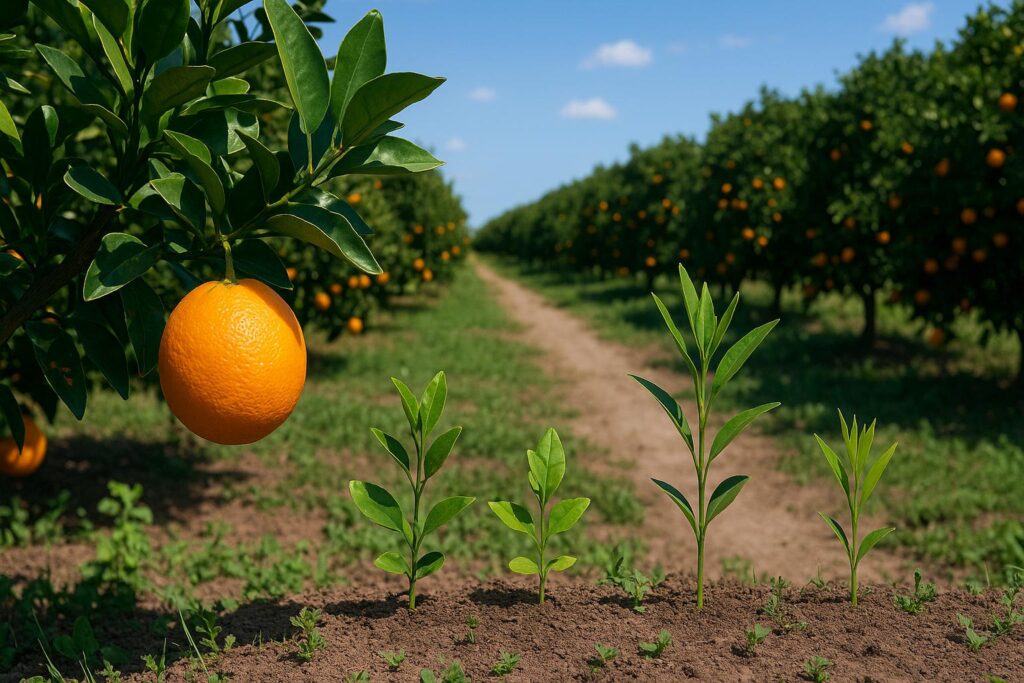In the vibrant world of citrus farming, where the taste, color, and marketability of fruit often determine a grower’s success, micronutrients have emerged as silent game-changers. These essential elements, though required in trace amounts, serve as the very levers that control fruit quality, plant resilience, and crop profitability. Citrus trees, especially, demand more than just routine care and traditional NPK fertilizers. They rely on a balanced matrix of micronutrients like zinc, boron, iron, and others to thrive, especially under commercial cultivation where yield and appearance are non-negotiable.
Without this balance, even lush, green trees can mask invisible deficiencies that stunt flowering, increase fruit drop, and reduce sweetness or shelf life. Understanding how this specialized mix of micronutrients transforms citrus farming isn’t just a scientific discussion—it’s an essential strategy for growers navigating the demands of modern horticulture.
The Hidden Micronutrient Deficiencies That Hurt Citrus Yields
On the surface, citrus orchards can appear healthy. Foliage may look vibrant and new flushes consistent. But underneath, micronutrient imbalances may be quietly sabotaging yield potential. The early signs of micronutrient deficiencies often appear subtly:
- Irregular flowering and poor fruit set
- Deformed or undersized fruits with dull coloration
These aren’t problems a basic NPK fertilizer can solve. Elements like zinc and boron play regulatory roles in everything from pollination to hormone production. Iron is critical for photosynthesis, while manganese and magnesium influence sugar metabolism and the texture of the rind.
When these micronutrients are deficient or locked in the soil, the plant silently prioritizes survival over productivity. This explains why experienced farmers increasingly turn toward tailored nutrition solutions. In citrus, where flowering synchrony and fruit quality define market value, the impact of precision feeding becomes dramatically visible.
Purchasing Arka Citrus Micronutrient Fertilizer, a crop-specific blend created to improve sugar delivery, decrease fruit loss, and enhance floral quality, is one of the most focused and field-proven methods for filling this gap. When used appropriately, it promotes citrus’s distinct nutrient physiology, guaranteeing that every stage of growth—from bud burst to ripening—is nourished.
Why Zinc, Boron, and Iron are Essential for Citrus
Each micronutrient contributes to a specific physiological function. Here’s how the most influential ones affect citrus performance:
Zinc: Hormonal Balance and Fruit Uniformity
Zinc facilitates auxin synthesis, a plant hormone that governs cell elongation and division. In citrus, this means better shoot growth, flowering consistency, and fruit shape. Deficiencies often result in “little leaf” disorder or clustered, small fruits.
Boron: Flowering, Pollination, and Fruit Retention
The development of cell walls and pollen viability depend on boron. By ensuring the proper development of pollen tubes during flowering, boron increases fruit set rates. Because it strengthens the vascular tissues that hold the fruit, it also lessens premature fruit drop
Iron: Photosynthetic Powerhouse
Iron is a catalyst for chlorophyll production. Interveinal chlorosis, or yellowing between leaf veins, is a symptom of iron-deficient trees, especially in young leaves. Because energy capture is driven by chlorophyll, iron-deficient trees yield smaller fruits with lower sugar content.
Manganese and Magnesium: Energy Transfer and Sugar Transport
While often neglected, these substances serve critical roles in the Krebs cycle and sugar loading into fruits. Manganese improves rind color and lessens physiological conditions such rind collapse, whereas magnesium maintains fruit size and juice content.
This micronutrient matrix works in concert to create a biosynergistic network that improves fruit marketability and tree longevity.
Field Trials and Measurable Impacts on Citrus Quality
Scientific evaluations back these micronutrient strategies. A study conducted by the Indian Institute of Horticultural Research (IIHR) found that citrus trees treated with balanced micronutrient blends exhibited:
- A 22–26% increase in fruit weight across different citrus cultivars
- Improved rind coloration and reduced albedo breakdown
- A 17% boost in total soluble solids (TSS), which directly enhances sweetness
These gains are not anecdotal. They result in premium market pricing, longer shelf life, and higher grade. Citrus exporters can get access to more stringent international markets where flavor and appearance are closely inspected with just a slight improvement in quality parameters.
Micronutrients are not optional—they are orchestral conductors of plant biochemistry. Miss one, and the entire performance suffers. – Dr. Ram Bhatia, Horticultural Scientist
Why Blends Perform Better Than Single Nutrient Sprays Due to Micronutrient Synergies
Sprays that only contain one nutrient can occasionally cause more harm than good. Zinc uptake, for instance, may be hampered by excessive iron application. High levels of phosphorus in the soil can inhibit the absorption of boron and manganese. These antagonisms are well documented in agronomic literature.
Crop-specific mixes are created for compatibility as well as nutrient supply. They are balanced with regard to:
- pH level and chelation for increased leaf absorption
- Ionic ratios to avoid nutrient lock-out or competition
- Application timing based on crop phenology
A peer-reviewed article on micronutrient interactions explains these synergistic and antagonistic relationships in depth. Applying a scientifically calibrated blend ensures nutrients enhance—rather than block—each other’s functions.
When and How to Apply: Timing is Everything
Even the best nutrient blend will underperform if applied at the wrong time. In citrus farming, three windows are considered optimal for foliar micronutrient feeding:
Pre-Flowering (Late Dormancy)
Zinc and boron applications here promote uniform bud break and improve pollen fertility. This is a foundational stage where setting the stage for successful fruit initiation is critical.
Fruit Set and Initial Growth
Magnesium and potassium are emphasized here, supporting sugar transport and cell division in the developing fruit.
Maturity and Ripening Stage
Calcium and boron preserve cell structure and stiffness, while iron and manganese sustain the integrity of chlorophyll and rind color.
Bypassing soil-based nutrient lock-up, the majority of micronutrient solutions made for foliar spray provide faster absorption. To prevent leaching, employ slow-release formulations if soil application is required.
Identifying Deficiencies Before It’s Too Late
Visual symptoms of micronutrient deficiency vary by nutrient and tree age. However, common signs in citrus include:
- Zinc deficiency: Rosette-shaped shoots, small narrow leaves
- Iron deficiency: Pale yellow new leaves with green veins
- Boron deficiency: Thick, brittle young leaves, fruit cracking
- Manganese deficiency: Mottled leaves with uneven yellow patches
Because visual symptoms appear late, regular tissue testing is a safer diagnostic method. A helpful resource like the CABI Crop Nutrition Guide offers image-based diagnosis and thresholds for intervention.
Micronutrients and Disease Resistance
Increased disease resistance is an underappreciated advantage of balanced micronutrient intake. By increasing cell wall stiffness, boron and calcium make it more difficult for pathogens to enter. Enzymes that counteract oxidative damage brought on by fungus or harsh environmental conditions are activated by zinc and manganese.
According to research from the Integrated Pest Management Program at the University of California, micronutrient-balanced plants have a 30% lower incidence of citrus canker and fungal leaf spot, particularly in humid environments.
Micronutrient blends are a key component of integrated orchard management because of their dual function of enhancing productivity and plant immunity.
Post-Harvest Quality: The Final Payoff
The benefits of micronutrient management don’t stop at harvest. Fruits that receive balanced micronutrient feeding tend to:
- Ripen more uniformly, improving post-harvest appearance
- Resist bruising, fungal decay, and skin breakdown during transit
- Retain internal firmness, sweetness, and gloss longer
Citrus fruits that are properly fed can last for an extra 5–7 days in cold storage, expanding their market reach and lowering post-harvest losses, according to exporters.
FAQs
- How often should micronutrients be applied in citrus?
Typically, two to three foliar applications per season aligned with phenological stages yield the best results. - Can I mix micronutrients with fungicides or insecticides?
Some combinations are compatible, but a jar compatibility test is recommended before mixing in the tank. - Are soil applications effective for micronutrients?
Soil application works for some nutrients like boron and magnesium but may suffer from soil pH lock-up. Foliar sprays ensure quicker and more targeted uptake of nutrients. - Is the micronutrient requirement the same for all citrus varieties?
While core needs are similar, some varieties, such as mandarins and acid limes, have slightly different requirements, especially for zinc and calcium.
Take the Next Step in Citrus Productivity
Micronutrients are often overlooked in favor of larger fertilizers or pest management. However, they are the unseen masterminds behind the quality of fruit in high-performance citrus production. Achieving the ideal balance affects not only yield but also the quality of each box of fruit you ship to the market.
Review the feeding program at your orchard. Examine whether your current fertilization strategy effectively supports fruiting phases and identify any potential shortcomings. With the correct micronutrient approach, a single season can yield benefits that are unmatched by growth regulators or pesticides.
Because the unseen chemistry occurring inside the leaves is frequently what separates excellent citrus farming from mediocrity.








Leave a Reply